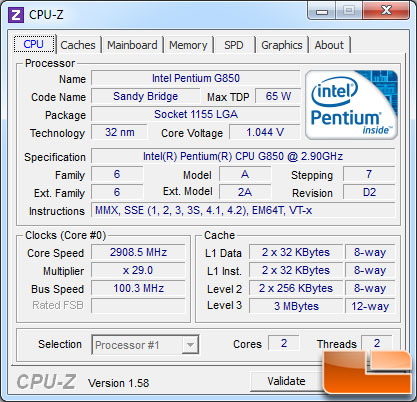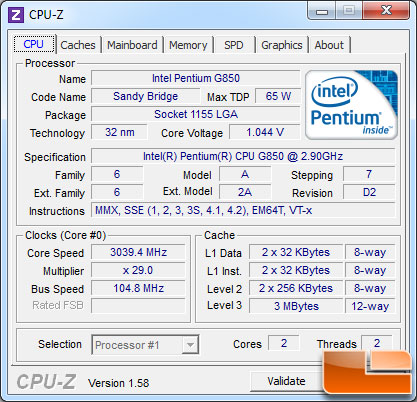Intel Pentium G850 Sandy Bridge 2.9GHz CPU Review
Intel Pentium G850 Overclocking
Overclocking greatly varies due to what hardware is being used and
who is doing the overclocking. Always remember that no two pieces of
hardware will perform the same, so our results will differ from what you
might be able to get. The Intel retail boxed CPU cooler was used for
overclocking, so we’d expect this overclock to be easily reached by
anyone!

Here is a CPU-Z v1.58 screen shot of the Intel Pentium G850 to see
what we are going to be overclocking. The processor has a base clock of
100MHz with a multiplier of 29. This is not a ‘K’ series processor,
which means it has a locked multiplier, so you can lower the multiplier
in the BIOS, but you can not increase it. The Pentium G850 also doesn’t
have Turbo Boost, so the only thing that we can do to really overclock
the CPU is to increase the base clock or bus frequency as some people call it. Intel ‘Sandy Bridge’
processors don’t like to have the bus increased too far though, so overclocking on
this processor is going to be rather tough.

With everything left to default in the BIOS and by just raising the
back clock frequency we were able to reach 105 MHz base clock in a matter
of seconds. This helped increase the overall frequency of the processor up to 3039 MHz, which is an increase of roughly 131 MHz.

We wanted to see how this benchmark performed as the CPU was now running at 3039MHz and the memory clock speed was at 1957MHz. We ran x264 HD 4.0 and sure enough we saw a performance increase from this simple and obviously effective overclock. We saw a 4.5% performance boost on the first pass, which is great as our overclock is only 4.9% in itself. It’s great to see a measurable performance difference from something this simple and the best part about overclocking is that it is an entirely free performance boost and it is fun to do!

Comments are closed.